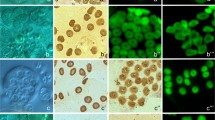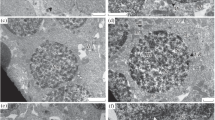Abstract
The ultrastructure of the early spermatogonia in mature testes of the platyfish, Xiphophorus maculatus, was compared to that of oogonia in mature ovaries of X. maculatus and the related X. nigrensis. Both cell types were very similar and, characterized as being large, oval to round cells containing large, central nuclei with prominent nucleoli. Abundant mitochondria with sparse transverse cristae were located at one pole or around the nucleus. Annulate lamellae and electron-dense granular material (nuage) were present. Other organelles were not prominent. A female that had received a testis graft had testicular tissue containing mature spermatozoa within the ovary, indicating that cells were present that could develop along the male line. Special crosses were carried out to obtain all-male embryos of X. maculatus and all-female embryos of X. nigrensis. The ultrastructure of the germ cells in all embryonic gonads was similar to that of the adult cells. These results suggest the presence of sexually undifferentiated germ cells in the adult gonads of both sexes. The support cells investing all of these germ cells were also similar structurally and appeared to be undifferentiated.
Similar content being viewed by others
References
Atz JW (1964) Intersexuality in fishes. In: Armstrong CN, Marshall AJ (eds) Intersexuality in vertebrates including man. Academic Press, New York, pp. 145–232
Azevedo C (1984) Development and ultrastructural autoradiographic studies of nucleolus-like bodies (nuages) in oocytes of a viviparous teleost (Xiphophorus hèlleri). Cell Tissue Res 238:121–128
Bellamy AW, Queal ML (1951) Heterosomal inheritance and sex determination in Platypoecilus maculatus. Genetics 36:93–107
Billard R (1969) La spermatogenèse du Poecilia reticulata. I-Estimation du nombre de générations goniales et rendement de la spermatogenèse. Ann Biol Anim Biochim Biophys 9:251–271
Billard R (1984) Ultrastructural changes in the spermatogonia and spermatocytes of Poecilia reticulata during spermatogenesis. Cell Tissue Res 237:219–226
Bluemink JG (1972) Cortical wound healing in the amphibian egg: an electron microscopical study. J Ultrastruct Res 41:95
Burgoyne PS, Buehr M, Koopman P, Rossant J, McLaren A (1988) Cell-autonomous action of the testis-determining gene: Sertoli cells are exclusively XY in XX ↔ XY chimaeric mouse testes. Development 102:443–450
Burns JR, Kallman KD (1985) An ovarian regression syndrome in the platyfish, Xiphophorus maculatus. J Exp Zool 233:301–316
Chan STH, Yeung WSB (1983) Sex control and sex reversal in fish under natural conditions. In: Hoar WS, Randall DJ, Donaldson EM (eds) Fish physiology, vol IXB. Academic Press, New York, pp 171–222
Cohen H (1946) Effects of sex hormones on the development of the platyfish, Platypoecilus maculatus. Zoologica 31:121–133
Eddy EM (1975) Germ plasm and the differentiation of the germ cell line. In: Bourne GH, Danielli JF (eds) International review of cytology, vol 43. Academic Press, New York, pp 229–280
Fuge H (1976) Ultrastructure of cytoplasmic nucleolus-like bodies and nuclear RNP particles in late prophase of tipulid spermatocytes. Chromosoma 56:363–379
Grier HJ, Horner J, Mahesh VB (1980) The morphology of enclosed testicular tubules in a teleost fish, Poecilia latipinna. Trans Am Microsc Soc 99:268–276
Gubbay J, Collignon J, Koopman P, Capel B, Economou A, Münsterberg A, Vivian N, Goodfellow P, Lovell-Badge R (1990) A gene mapping to the sex-determining region of the mouse Y chromosome is a member of a novel family of embryonically expressed genes. Nature 346:245–250
Hamaguchi S (1982) A light- and electron-microscopic study on the migration of primordial germ cells in the teleost, Oryzias latipes. Cell Tissue Res 227:139–151
Ito S, Karnovsky MJ (1968) Formaldehyde-glutaraldehyde fixatives containing trinitro compounds. J Cell Biol 39:168a
Kallman KD (1960) Dosage and additive effects of histocompatibility genes in the teleost Xiphophorus maculatus. Ann NY Acad Sci 87:10–43
Kallman KD (1975) The platyfish, Xiphophorus maculatus. In: King RC (ed) Handbook of genetics, vol 4. Plenum Press, New York, pp 81–132
Lofts B (1974) Reproduction. In: Lofts B (ed) Physiology of the amphibia, vol 2. Academic Press, New York, pp 107–218
Lofts B (1975) Environmental control of reproduction. Zool Soc London Symp 35:177–197
McLaren A (1983) Does the chromosomal sex of a mouse germ cell affects its development? In: McLaren A, Wylie CC (eds) Current problems in germ cell differentiation, Cambridge University Press, Cambridge, pp 225–240
Redshaw MR (1972) The hormonal control of the amphibian ovary. Am Zool 12:289–306
Reynolds ES (1963) The use of lead citrate at high pH as an electron-opaque stain in electron microscopy. J Cell Biol 17:208
Satoh N (1974) An ultrastructural study of sex differentiation in the teleost Oryzias latipes. J Embryol Exp Morphol 32:195–215
Sinclair AH, Berta P, Palmer MS, Hawkins JR, Griffiths BL, Smith MJ, Foster JW, Frischauf A-M, Lovell-Badge R, Goodfellow PN (1990) A gene from the human sex-determining region encodes a protein with homology to a conserved DNA-binding motif. Nature 346:240–244
Takeuchi IK, Takeuchi YK (1982) Ultrastructural and cytochemical studies on nucleolus-like bodies in early postimplantation rat embryos. Cell Tissue Res 226:257–266
Toury R, Clérol J-C, André J (1977) Les groupements mitochondriaux des cellules germinales des poissons Téléostéen Cyprinidés. IV. Analyse biochimique des constituants du “ciment” intermitochondrial isolé. Biol Cell 30:225–232
Wallace RA, Selman K (1978) Oogenesis in Fundulus heteroclitus. I. Preliminary observations on oocyte maturation in vivo and in vitro. Dev Biol 62:354–369
Yamamoto T (1969) Sex differentiation. In: Hoar WS, Randall DJ (eds) Fish physiology, vol 3. Academic Press, New York, pp 117–175
Author information
Authors and Affiliations
Rights and permissions
About this article
Cite this article
Flores, J.A., Burns, J.R. Ultrastructural study of embryonic and early adult germ cells, and their support cells, in both sexes of Xiphophorus (Teleostei:Poeciliidae). Cell Tissue Res 271, 263–270 (1993). https://doi.org/10.1007/BF00318612
Received:
Accepted:
Issue Date:
DOI: https://doi.org/10.1007/BF00318612




